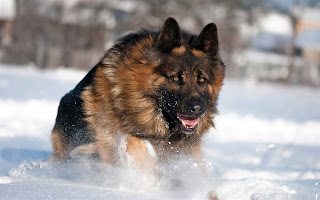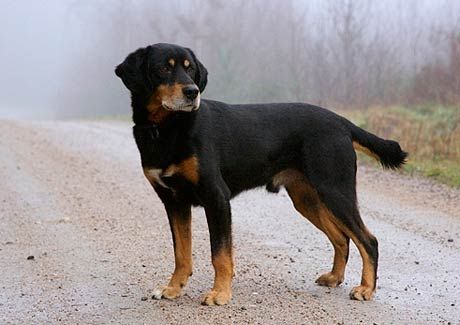Winter Care Tips For Your Dog
For some of us, cold weather is regarded as a mere nuisance; for others, it’s a fun time filled with snowboarding, skiing and other winter joys; and still others will find this time of bone-chilling weather and huge piles of snow a veritable nightmare to endure.
Whatever your viewpoint on winter, one thing remains the same for all of us with pets: it’s a time when our beloved babies need a little extra care.
1. Consider a coat.
There are a few kinds of dogs who can benefit from a sweater or coat while outside. Dogs with short legs, like a Basset Hound or Corgi, may benefit from clothing to keep them warm, because their stature puts them in closer contact with snow. Dogs with a thin body type, like Greyhounds or Whippets, especially those with short fur, may benefit from a coat. Additionally, certain health conditions can make it difficult for affected dogs to regulate their body temperatures, so a sweater or coat for those pets couldn’t hurt.
Tips: Do Dogs Need Sweaters in Winter?
2. Go outside when the sun shines
If your dog feels the cold, try to walk him in the late morning or early afternoon hours when temperatures are a little warmer, and avoid early morning or late evening walks. Spend time playing outdoors while it’s sunny; sunshine brings the added benefit of providing both you and your pet with vitamin D. Play fetch with toys, not sticks, which can cause choking and other injuries. So, if your dog likes to chew and chase, pack a Frisbee, ball or other safe toy and play together in the sun.
3. No More Frozen Dinners!
Because it takes more energy to stay warm when it’s cold, outdoor animals eat more during the winter. Likewise, fresh, running water is vital for maintaining your pet’s health. Keep an eye on the water bowls and make sure they haven’t turned into little skating rinks for fleas . While ice pops might be a fun treat, your pet really doesn’t want to have to lick a frozen lump of ice to get his water.
4. Cozy bedding
In addition to limiting your dog’s time outdoors on cold days, don’t let your pooch sleep on a cold floor in winter. Choosing the right bedding is vital to ensure your dog stays warm. Warm blankets can create a snug environment; raised beds can keep your dog off cold tiles or concrete, and heated pet beds can help keep the stiffness out of aging joints. Place your dog’s bed in a warm spot away from drafts, cold tile or uncarpeted floors, preferably in a favorite spot where he sleeps every day so that the area doesn’t feel unfamiliar.
5. Learn how to walk safely in winter weather.
Walking your dog in winter doesn’t have to be miserable or unsafe, provided you take proper precautions to protect yourself and your pet from conditions like wind, snow and ice. Be sure you and your dog are both properly outfitted — that includes protecting your dog’s paws from ice and deicing agents with booties or pet-safe gels. Use a front-clip harness to discourage pulling and a solid leash as opposed to a retractable one. When you’re out walking, be sure to avoid hazards like frozen ponds and make sure your dog’s clothing stays dry. And don’t forget to wipe your dog’s paws afterward — many salts and ice-melters are toxic to pets.
And remember, it’s important to listen to your dog. If he’s shaking, cowering or attempting to head back home, it might be too cold for him.
6. Find exercise alternatives.
Some days, winter conditions like ice or extreme cold may prevent both you and your dog from getting outside, but that doesn’t mean he can’t get some exercise. Consider playing tug or fetch, creating your own agility course inside, or feeding a small portion of your dog’s food from a food puzzle. Just remember, when you’re playing games like fetch, it’s best to do these things on a carpeted surface, rather than on hardwood floors, which can be slippery.
7. Protect your dog from heaters
Dogs will often seek heat during cold winter weather by snuggling too close to heating sources. Avoid space heaters and install baseboard radiator covers to avoid your pet getting burned. Fireplaces also pose a major threat so please make sure you have a pet proof system to keep your heat-seeking pal out of harm’s way!
8. Moisturize
Dry and cold weather can do a number on your pet’s skin. Help prevent dry, flaky skin by adding a skin and coat supplement to his food. Coconut and fish oils are easy foods that can help keep your pet’s skin and coat healthy. If you find your pet’s paws, ears or tail are dry or cracking, you can also apply coconut oil topically as needed.
9. Latest Fad Diet?
Indoor animals, meanwhile, have different dietary needs. They conserve energy by sleeping more in the winter. Dogs and cats also exercise much less when they do go outside, so you may need to adjust the amount of food accordingly. After all, no one wants an overweight pet.
10. Dogs also should be kept inside if possible.
If kept outside, they should have a draft-free shelter large enough to stand and turn around in, yet small enough to retain body heat. Use a layer of straw or other bedding material to help insulate your pet against the cold. Different breeds of dogs have different sheltering needs. Purchase a commercially produced doghouse, or contact your local humane society for construction plans for a doghouse suitable for your climate. Please be sure to contact your veterinarian if you have questions.
11. Keep your dog hydrated
Dogs can dehydrate just as quickly in winter as summer. Although many dogs eat snow, it’s not an adequate substitute for fresh water. If your dog spends time outdoors in your yard, make sure he has access to a water bowl, check it often and break ice that forms on top.
12. Groom your dog
Your dog needs a clean, well-groomed coat to keep him properly insulated. This is especially important if your dog spends a lot of time outdoors. After bathing, dry your dog thoroughly, especially before allowing him outside
13. The Deadly Drink
The worst of all the wintertime chemical spills is antifreeze, which often leaks from a car’s radiator. It may taste delicious to your cats or dogs, but it is extremely deadly — even the smallest sip can be fatal. If your pet starts acting “drunk” or begins to convulse, take him to the vet immediately. Better yet, keep all pets away from the garage and clean up any accidental spillage. You should also not let your dog wander too far during his walks. Who knows what dangers lie in your neighbors’ driveways?
14. Snow removal
Snow can be a lot of fun but also dangerous for your dog. Snow piled near fences offers your dog escape routes that even well trained dogs often can’t resist. When you clear snow in your yard, pile it away from fences to prevent your dog from climbing over. Snow and ice often accumulate on rooftops and if the sun is out or as temperatures rise, this accumulation can slide and injure your dog. If you can’t clear the snow from the roof, keep your dog away from the roof overhang to prevent injury.
15. Paw care is a must
Just as we tend to develop foot cracks in winter, dogs can also suffer from cracked pads. If your dog has furry feet, trim the hair that grows between his pads to prevent ice buildup between the pads. Winter salt on city sidewalks can also burn your dog’s pads and is toxic, so after walks around the neighborhood, rinse or wipe your dog’s paws to remove any salt – you don’t want him licking it off. If your dog shows signs of discomfort when walking outside on frozen or salted surfaces, consider using dog booties to protect his paws
16. Salty Solution
Do you live in an area with cold and icy winters? Then you are probably accustomed to salt on the sidewalks and roads. However, the types of salt used to melt ice and snow and keep it from refreezing are somewhat harsh on delicate paws – not to mention they corrode concrete and damage the beautiful vegetation. Protect your pet’s paws, and keep him warm during walks, by outfitting him with booties.
17. Never leave your dog unattended in the car, no matter what the season
Just as cars can get dangerously hot in summer, freezing cold temperatures are equally dangerous for your dog in winter. Leaving the car running involves additional risks, including carbon monoxide poisoning if the car is parked in a garage. Leave your dog at home when you go out to run errands.
18. Joy Ride
Cars are particularly attractive to animals in the winter-time, especially frigid cats that love to climb up under the hood and curl up on the warm motor. This, as you can imagine, has led to many mishaps when motorists start their car … ouch! Avoid such accidents by tapping your car’s hood before starting the vehicle. Sure, you may wake Kitty from her deep slumber, but she’ll thank you in the long run.
19. Watch where your dog plays
Although your dog is likely to be having a great time outdoors, take frequent indoor breaks for water and warming and don’t ever stay out too long. If you’re walking or playing in unfamiliar areas, keep your dog close. It’s easy for him to venture onto unsafe surfaces such as frozen ponds or lakes. These may be covered in snow and not easily visible.
20. Special care for seniors
Cold weather will often aggravate existing medical conditions in dogs, particularly arthritis. It’s very important to maintain an exercise regimen with your arthritic dog, but be mindful of slippery surfaces and make sure your dog has a warm soft rest area to recuperate after activity. If you don’t already give your senior dog a natural joint supplement to lubricate the joints and ease the discomfort of arthritis, you may want to consider adding one in winter. Just like people, dogs are more susceptible to other illnesses during winter weather.
Winter often brings colder temperatures and elements like wind, sleet and snow. But that doesn’t mean you and your dog have to hibernate until spring. Here are some things you can do to help prepare your dog for winter and keep him happy, healthy and active during the colder months.
More informations: Protect Your Dog During Winter and Cold Weather






